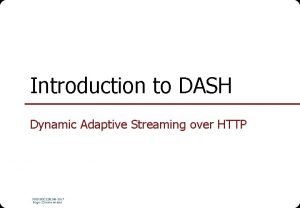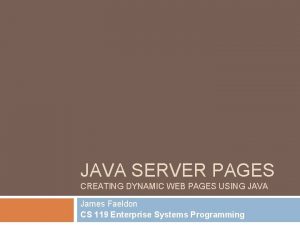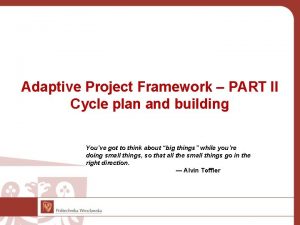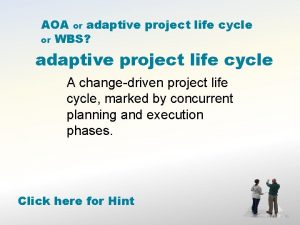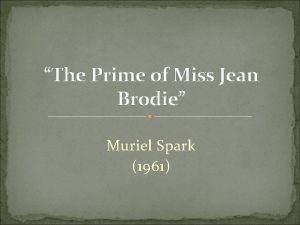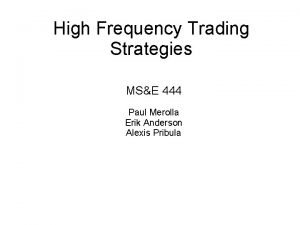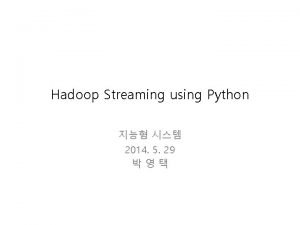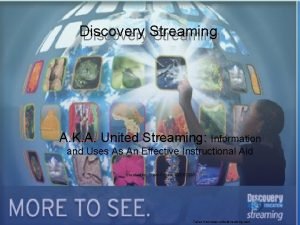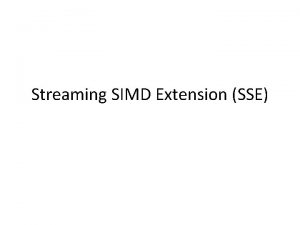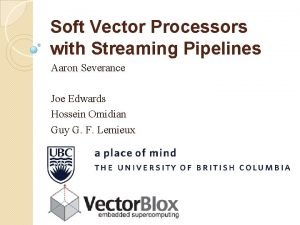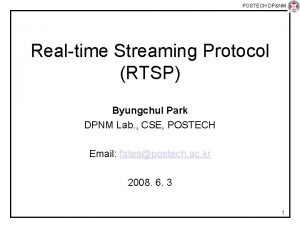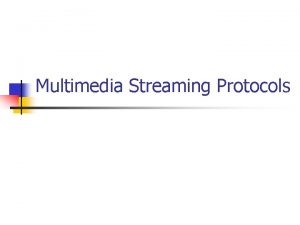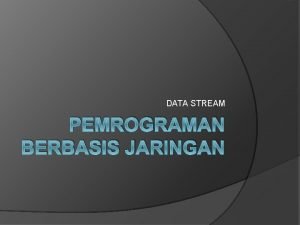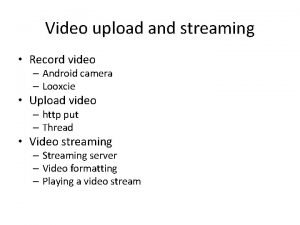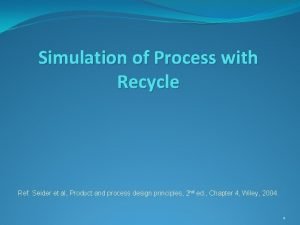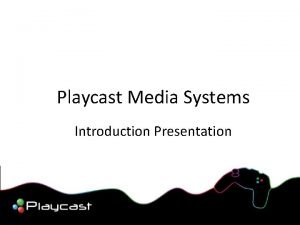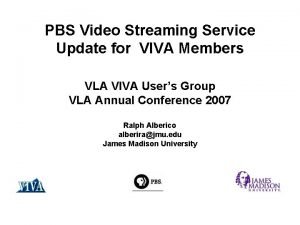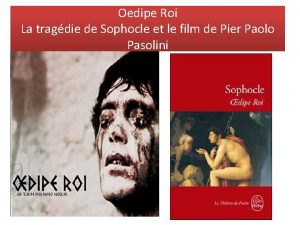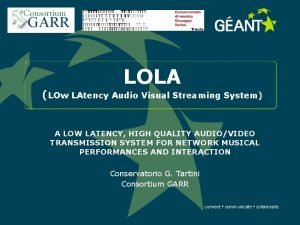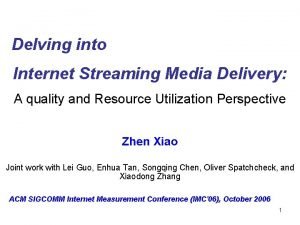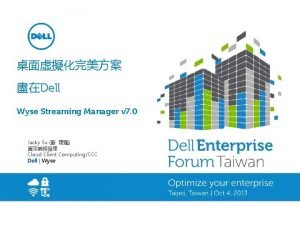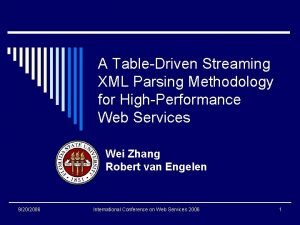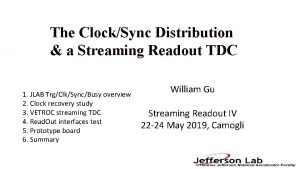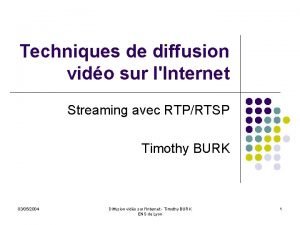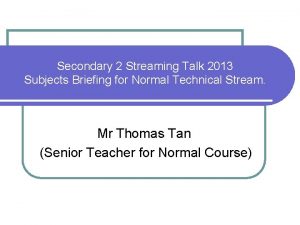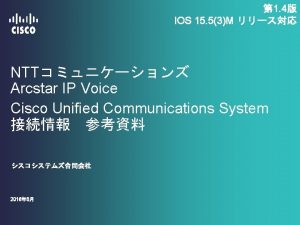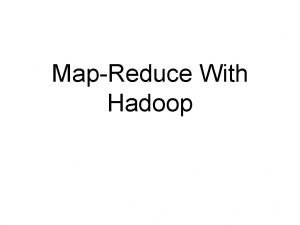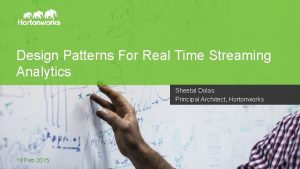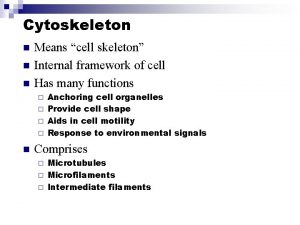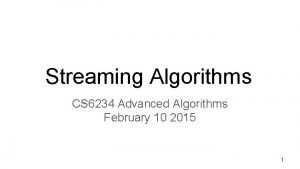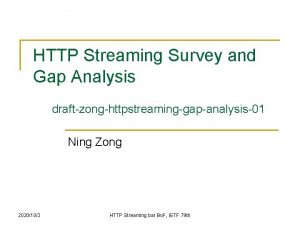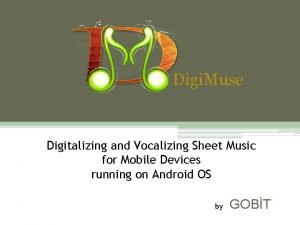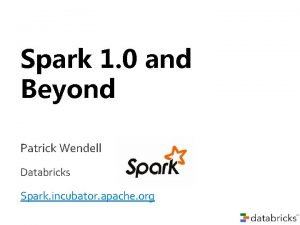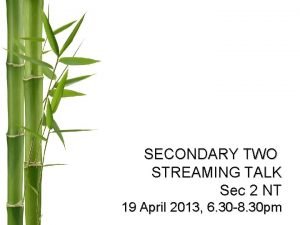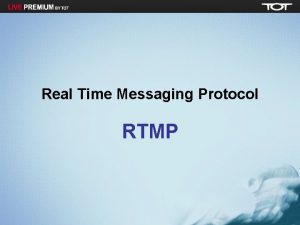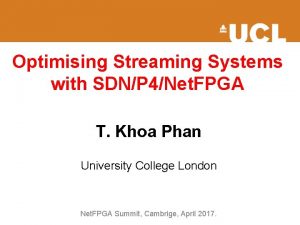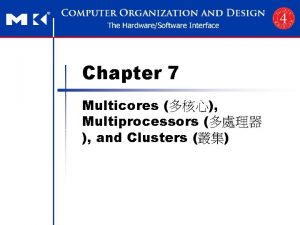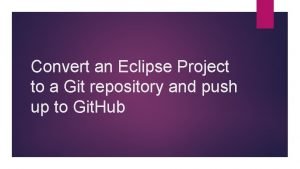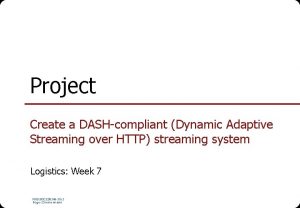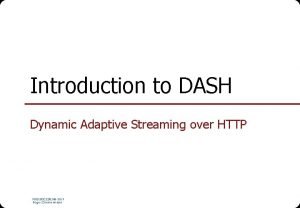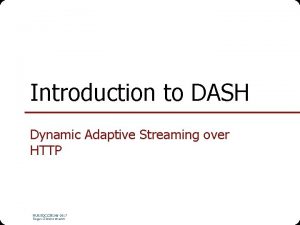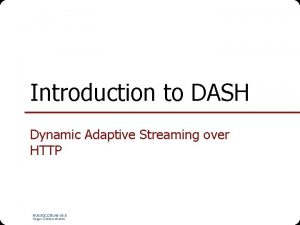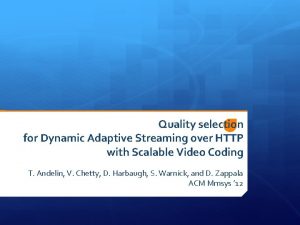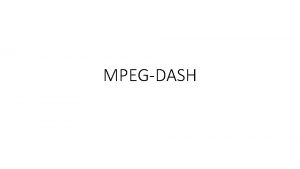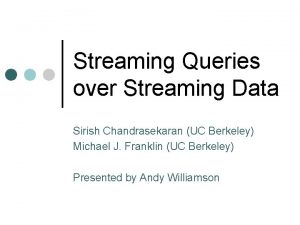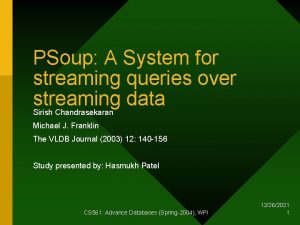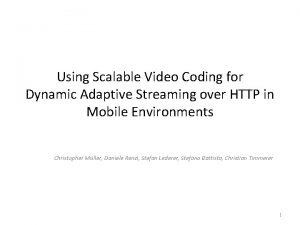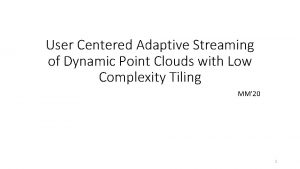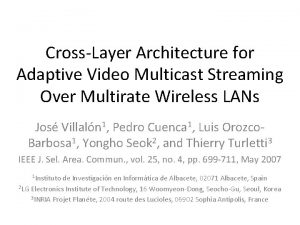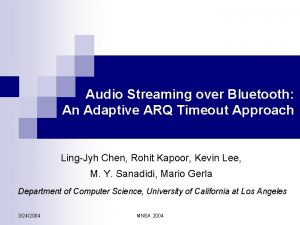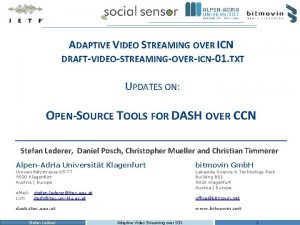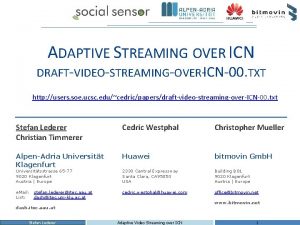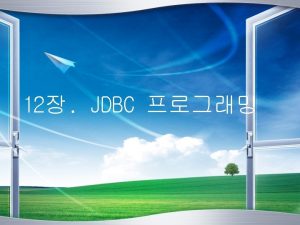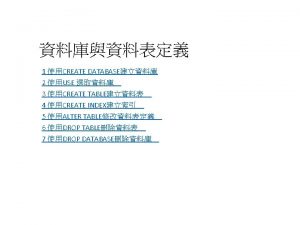Project Create a DASHcompliant Dynamic Adaptive Streaming over































![Disk Service Time Model – – – TTransfer: data transfer time [s] TAvg. Rot. Disk Service Time Model – – – TTransfer: data transfer time [s] TAvg. Rot.](https://slidetodoc.com/presentation_image_h/743eb9a8738b1af210da58df5bfd1ea5/image-32.jpg)





















![Linux Client n Operation: n [List] button: reads media entries from local Yima. cfg Linux Client n Operation: n [List] button: reads media entries from local Yima. cfg](https://slidetodoc.com/presentation_image_h/743eb9a8738b1af210da58df5bfd1ea5/image-54.jpg)
![Windows Client n Operation: n [List] button: reads media entries from local Yima. cfg Windows Client n Operation: n [List] button: reads media entries from local Yima. cfg](https://slidetodoc.com/presentation_image_h/743eb9a8738b1af210da58df5bfd1ea5/image-55.jpg)

- Slides: 56

Project Create a DASH-compliant (Dynamic Adaptive Streaming over HTTP) streaming system NUS. SOC. CS 5248 -2012 Roger Zimmermann

Goals (1) n Capture a video on an ASUS Transformer tablet computer and store it as an MP 4 file. n Split the MP 4 file into streamlets, i. e. , 3 second long video files. n Upload the streamlets to a web server. n Transcode the streamlets into 3 different streamlets (e. g. , low, medium, high quality). n Create a playlist on the web server. NUS. SOC. CS 5248 -2012 Roger Zimmermann

Goals (2) n ASUS Transformer runs the Android 4. 0 Ice Cream Sandwich OS. n Programming on Android is done in Java with the Eclipse IDE. n On the web server, create scripts in the PHP language. n Implement a simple Android DASH media player. NUS. SOC. CS 5248 -2012 Roger Zimmermann

Project Homepage n Descriptions and web links n Some utilities and some library source codes n Documentation (RFCs, etc. ) n IVLE Forums n TA: Wang Guanfeng NUS. SOC. CS 5248 -2012 Roger Zimmermann

Advice and Actions (1) n Form a team (3 persons). n Note: You will need to read and learn a lot. Your program code will be quite small. n HTTP POST command structure n MP 4 Parser usage to create streamlets n FFmpeg transcoder usage n Playlist. m 3 u 8 format in XML n Start early (i. e. , this week)! NUS. SOC. CS 5248 -2012 Roger Zimmermann

Actions (2): Get your Tablet n Check out your loan ASUS Transformer for the project from So. C Technical Services (on the first floor of COM 1). n There is one tablet per team (3 students). n Please make an appointment with Mr. Chow Chin Ming to get your tablet. Email: chowcm@comp. nus. edu. sg. n Tell Mr. Chow the 3 team member names. NUS. SOC. CS 5248 -2012 Roger Zimmermann

Introduction to DASH Dynamic Adaptive Streaming over HTTP NUS. SOC. CS 5248 -2012 Roger Zimmermann

DASH (1) n RTP/RTSP/RTCP streaming faces several challenges n Special-purpose server for media (complex) n Protocols use TCP and UDP transmissions (firewalls) n Difficult to cache data (no “web caching”) n Advantage n Short end-to-end latency NUS. SOC. CS 5248 -2012 Roger Zimmermann

DASH (2) n Main idea of DASH n Use HTTP protocol to “stream” media n Divide media into small chunks, i. e. , streamlets n Advantages n Server is simple, i. e. , regular web server n No firewall problems (use port 80 for HTTP) n Standard (image) web caching works NUS. SOC. CS 5248 -2012 Roger Zimmermann

DASH (3) n Original DASH implementation by Move Networks n Introduced concept of streamlets n Additional idea: make playback adaptive n NUS. SOC. CS 5248 -2012 Roger Zimmermann Encode media into multiple different streamlet files, e. g. , a low, medium, and high quality version (different bandwidth)

DASH (4) MPD: Media Presentation Description n ISO/IEC Standard: n “Information technology — MPEG systems technologies — Part 6: Dynamic adaptive streaming over HTTP (DASH)” n JTC 1/SC 29; FCD 23001 -6 NUS. SOC. CS 5248 -2012 Roger Zimmermann

DASH (5) n Web server provides a playlist n The playlist is a file in a specific format that lists all the available qualities and all the streamlets for each quality n Playlist file extension is. m 3 u 8 n Content preparation: n Original media file needs to be split into streamlets n Streamlets need to be transcoded into different qualities NUS. SOC. CS 5248 -2012 Roger Zimmermann

DASH (6) n HTTP protocol is stateless! n Server remembers “nothing” about session n Scheduling logic, etc. , is in media player! NUS. SOC. CS 5248 -2012 Roger Zimmermann

DASH (7) n DASH media player n Loads. m 3 u 8 file and then starts to download streamlets n All the scheduling logic is in the player n Render current streamlet while downloading the next streamlet before playback is done n Measure bandwidth and switch between different qualities (i. e. , adapt) n Switch servers can be done easily NUS. SOC. CS 5248 -2012 Roger Zimmermann

DASH (8) n Many media players now understand DASH streaming format n Many companies use HTTP streaming: n Move Networks, Apple, Microsoft, Netflix, … n CDNs like this approach n No need to run Quick. Time, Windows Media, Real. Networks, and Flash streaming servers n Just use web server for everything! NUS. SOC. CS 5248 -2012 Roger Zimmermann

Continuous Media Servers n Introduction n Continuous Media n Magnetic Disk Drives n Display of CM (single disk, multi-disks ) n Optimization Techniques n Additional Issues n Case Study (Yima)

What is a CM Server? Network Storage Manager Memory n Multiple streams of audio and video should be delivered to many users simultaneously.

Some Applications n Video-on-demand n Medical databases n News-on-demand n NASA databases n News-editing n Movie-editing n Interactive TV n Digital libraries n Distance Learning

Continuous Display n Data should be transferred from the storage device to the memory (or display) at a pre-specified rate. n Otherwise: frequent disruptions & delays, termed hiccups. n NTSC quality: 270 Mb/s uncompressed; 3 -8 Mb/s compressed (MPEG-2). Memory Disk

Challenge: Real-Time Media § Bandwidth requirements for different media types: 100 Mb/s 50 Mb/s 31 Mb/s 4 -6 Mb/s 1 Mb/s 20 Mb/s

High Bandwidth & Large Size n HDTV quality ~ 1. 4 Gb/s Uncompressed! Standard: SMPTE 292 M n 2 -hr HDTV ~ 1260 GB

Streaming Media Servers n Streaming media servers require a different “engine” than traditional databases because of: n Real-time retrieval and storage n Large media objects n The performance metrics for streaming media servers are: n The number of simultaneous displays: throughput N The amount of time that elapses until a display starts: n The overall cost of the system: cost per stream, C n startup latency L

Media Types n Examples of continuous media are: Audio n Video n Haptics n Continuous media are often compressed. There are many different compression algorithms, for example: n Motion Picture Experts Group: MPEG-1, MPEG-2, MPEG-4 n Joint Photographic Expert Group: Motion-JPEG n Digital Video: DV, Mini. DV n Microsoft Video 9, Div. X, … Others: n MP 3: MPEG-1 layer 3 audio – Wavelet-based codecs n Above codecs are based on – Lossless compression discrete cosine transform (DCT) n

Compression n MPEG-1 180: 1 reduction in both size and bandwidth requirement (SMPTE 259 M, NTSC 270 Mb/s is reduced to 1. 5 Mb/s). n MPEG-2 30: 1 to 60: 1 reduction. (NTSC ~ 4, DVD ~ 8, HDTV ~ 20 Mb/s) n Problem: loose information (cannot be tolerated by some applications: medical, NASA)

Media Characteristics n Data requires a specific bandwidth: n Constant bitrate (CBR) CM n Variable bitrate (VBR) CM n Easier case: CBR n Data is partitioned into equi-sized blocks which represent a certain display time of the media n E. g. : 176, 400 bytes represent 1 second of playtime for CD audio (44, 100 samples per second, stereo, 16 -bits per sample)

Assumed Hardware Platform n Multiple magnetic disk drives: n n Not too expensive (as compared to RAM) Not too slow (as compared to tape) Not too small (as compared to CD-ROM) And it’s already everywhere! Memory

Magnetic Disk Drives n An electro-mechanical random access storage device n Magnetic head(s) read and write data from/to the disk Drive Internals

Disk Device Comparison

Disk Seek Characteristic

Disk Seek Time Model If d < z cylinders If d >= z cylinders

Disk Service Time n The disk service time is dependent on several factors: n Seek time n Platter diameter (e. g. , 3. 5”, 2. 5”, 1”) n Rotational latency n Spindle speed n Data transfer time n Zone-bit recording n Read versus write bandwidth
![Disk Service Time Model TTransfer data transfer time s TAvg Rot Disk Service Time Model – – – TTransfer: data transfer time [s] TAvg. Rot.](https://slidetodoc.com/presentation_image_h/743eb9a8738b1af210da58df5bfd1ea5/image-32.jpg)
Disk Service Time Model – – – TTransfer: data transfer time [s] TAvg. Rot. Latency: average rotational latency [s] TService: service time [s] B: block size [MB] BWEffective: effective bandwidth [MB/s]

Data Retrieval Overhead

Sample Calculations • Assumptions: – TSeek = 10 ms – BWMax = 20 MB/s – Spindle speed: 10, 000 rpm

Summary n Average rotational latency depends on the spindle speed of the disk platters (rpm). n Seek time is a non-linear function of the number of cylinders traversed. n Average rotational latency + seek time = overhead (wasteful). n Average rotational latency and seek time reduce the maximum bandwidth of a disk drive to the effective bandwidth

Continuous Display (1 disk) Retrieve from disk Display from memory X 1 X 2 Display X 1 X 3 Display X 2 Display X 3 Time n n n Traditional production/consumption problem RC = Consumption Rate, e. g. , MPEG-1: 1. 5 Mb/s. RD = Production Rate, Seagate Cheetah X 15: 40 -55 MB/s. For now: RC < RD Partition video X into n blocks: X 1, X 2, . . . , Xn (to reduce the buffer requirement)

Retrieve from Disk Display from Memory X 1 Seek Time Round-robin Display Y 3 Display X 1 Y 4 X 2 Display Y 3 Display Y 4 Time n Time period: time to display a block (is fixed). n System Throughput (N): number of streams. n Assuming random assignment of the blocks: n n n X 3 Maximum seek time between block retrievals Waste of disk bandwidth ==> lower throughput Tp=? , N=? , Memory=? , max-latency=? Y 5 Display X 3 Display Y 5

Cycle-based Display Retrieve from Disk X 1 Display from Memory Y 3 Z 5 Z 6 Y 4 X 2 Y 5 X 3 Z 7 Display X 1, Y 3, Z 5 Display X 2, Y 4, Z 6 Time n Using disk scheduling techniques n Less seek time ==> Less disk bandwidth waste ==> Higher throughput n Larger buffer requirement Tp=? , N=? , Memory=? , max-latency=? n

Group Sweeping Schema (GSS) Group 1 W 1 X 1 Subcycle 1 Group 2 Y 3 Z 5 X 2 Z 6 Y 4 W 3 X 3 Subcycle 2 Display X 1, W 1 n n n W 2 Display X 2, W 2 Can shuffle order of blocks retrievals within a group Cannot shuffle the order of groups GSS when g=1 is cycle-based GSS when g=N is round-robin Optimal value of g can be determined to minimize memory buffer requirements n Tp=? , N=? , Memory=? , max-latency=? Z 7 Y 5

System Issues n Movie is cut into equi-sized blocks: X 0, X 1, …, Xn-1. n Time required to display one block is called time period Tp. n Note: Tp is usually longer than the disk retrieval time of a block; this allows multiplexing of a disk among different displays. Server Retrieval Network Buffer Display X 0 X 1 X 0 Time X 2 X 1 X 0 Time period Buffer empty X 1 X 2 Hiccup

Constrained Data Placement n Partition the disk into R regions. n During each time period only blocks reside in the same region are retrieved. n Maximum seek time is reduced almost by a factor of R. n Introduce startup latency time n Tp=? , N=? , Memory=? , max-latency=?

Hybrid n For the blocks retrieved within a region, use GSS schema. n This is the most general approach; Tp=? , N=? , Memory=? , max-latency=? By varying R and g all the possible display techniques can be achieved. Round-robin (R=1, g=N). Cycle-based (R=1, g=1). Constrained placement (R>0, g=1), . . . A configuration planner calculates the optimal values of R & g for certain application. n n n

Display of Mix of Media Retrieve from Disk X 1 Y 3 Z 5 Display from Memory Z 6 Y 4 X 2 Y 5 X 3 Z 7 Display X 1, Y 3, Z 5 Display X 2, Y 4, Z 6 Time n Mix of media types: different RC’s: audio, video; e. g. : Rc(Y) < Rc(X) < Rc(Z) n Different block sizes: Rc(X)/B(X)=Rc(Y)/B(Y)=. . . n Display time of a block (time period) is still fixed.

Multiple-disks n Single disk: even in the best case with 0 seek time, 240/1. 5 = 160 MPEG-1 streams. n Typical applications (MOD): 1000’s of streams. n Solution: aggregate bandwidth and storage space of multiple disk drives. n How to place a video? Memory

RAID Striping n All disks take part in the X 1 transmission of a block. n Can be conceptualized as a single disk. n Even distribution of display load. d 1 d 2 d 3 n Efficient admission. n Is not scalable in throughput. X 1. 1 X 2. 1 X 1. 2 X 2. 2 X 1. 3 X 2. 3

Round-robin Retrieval d 1 d 2 d 3 n Only a single disk takes part in the transmission of each block. n Retrieval schedule n X 1 Y 1 Z 3 W 3 Retrieval Schedule d 1 d 2 d 3 Round-robin retrieval of the blocks. n Even distribution of Time display load. n Efficient admission. n Not scalable in latency. W 2 X 2 Y 2 Z 1 X 3 Y 3 Z 2 W 1 Display X 1, Y 1, W 1, Z 1 X 2, Y 2, W 2, Z 2 X 3, Y 3, W 3, Z 3

Hybrid Striping n Partition D disks into clusters of d disks. n Each block is declustered across the d disks that constitute a cluster (each cluster is a logical disk drive). n RAID striping within a cluster. n Round-robin retrieval across the clusters. n RAID striping (d=D), Round-robin retrieval (d=1).

Introduction to Yima PE Personal Edition Streaming Media System NUS. SOC. CS 5248 -2012 Roger Zimmermann

Overview n Command line server n GUI client n “Split” utility to prepare media files n RTSP communication (port 5 xxxx) NUS. SOC. CS 5248 -2012 Roger Zimmermann #. /yimaserver <Yima. PE 1. 0> begin scheduler <Yima. PE 1. 0> begin rtsps

Software Source n Directories n Server n Client n Splitter n Streams Server code Client code and GUI library Media preparation utility Sample media (WAV file) n Remove all object files (*. o) before building the executables NUS. SOC. CS 5248 -2012 Roger Zimmermann

Yima PE Server n RTSP front and backend (one process) n Scheduler + FLIB (one process) n Qpthread v 1. 3. 1 library for multi-threading n Must set LP_LIBRARY_PATH to include Qpthread n Server configuration file: config n n Where are the media files located Name, size [bytes] and duration [sec] NUS. SOC. CS 5248 -2012 Roger Zimmermann

Splitter n Input: yimaintro. wav (for example) n Output: BLOCKS sub-directory n Data block files: yimaintro. wav_1, yimaintro. wav_2, … n Each block is 256, 000 bytes and contains 500 RTP packets (of 512 bytes each) n A sample config file is created; must copy contents to the main config file NUS. SOC. CS 5248 -2012 Roger Zimmermann

Server + Splitter n Server does not care about block contents, i. e. , it does not know what kind of media data is stored (MPEG-1/2, WAVE, …) n Server sends RTP packets based on config info: n BW = size / duration n Packet-level scheduling n Need only modify splitter for MP 3 media! NUS. SOC. CS 5248 -2012 Roger Zimmermann
![Linux Client n Operation n List button reads media entries from local Yima cfg Linux Client n Operation: n [List] button: reads media entries from local Yima. cfg](https://slidetodoc.com/presentation_image_h/743eb9a8738b1af210da58df5bfd1ea5/image-54.jpg)
Linux Client n Operation: n [List] button: reads media entries from local Yima. cfg file n [Play], [Pause], [Stop] buttons execute RTSP commands to server n GUI was built with XForms library; it is message-driven, with callback functions for buttons, etc. Plays uncompressed audio (PCM). NUS. SOC. CS 5248 -2012 Roger Zimmermann
![Windows Client n Operation n List button reads media entries from local Yima cfg Windows Client n Operation: n [List] button: reads media entries from local Yima. cfg](https://slidetodoc.com/presentation_image_h/743eb9a8738b1af210da58df5bfd1ea5/image-55.jpg)
Windows Client n Operation: n [List] button: reads media entries from local Yima. cfg file n [Play], [Pause], [Stop] buttons execute RTSP commands to server n GUI was built with Visual Studio C/C++ (MFC library); it is message-driven, with callback functions for buttons. Includes MP 3 decoder. NUS. SOC. CS 5248 -2012 Roger Zimmermann

Client Structure n 3 threads Player “P” n State machine GUI “C” Buffer Network “N” Command Message Queues, e. g. , put_cmd(Cto. N, …); NUS. SOC. CS 5248 -2012 Roger Zimmermann /dev/dsp RTP RTSP
 Dynamic adaptive streaming over http implementation
Dynamic adaptive streaming over http implementation Jika noel(create(q)) adalah 0, maka front(create(q)) adalah
Jika noel(create(q)) adalah 0, maka front(create(q)) adalah How to create a dynamic web page in jsp
How to create a dynamic web page in jsp Adaptive project framework
Adaptive project framework Adaptive project life cycle
Adaptive project life cycle Transferered
Transferered Over the mountains over the plains
Over the mountains over the plains Siach reciting the word over and over
Siach reciting the word over and over Explain how to handing over and taking over the watch
Explain how to handing over and taking over the watch Ball setting and streaming
Ball setting and streaming Twitter sentiment analysis using spark streaming and kafka
Twitter sentiment analysis using spark streaming and kafka Handling of time in the prime of miss jean brodie
Handling of time in the prime of miss jean brodie Streaming xxnx
Streaming xxnx Hadoop streaming python
Hadoop streaming python United discovery streaming
United discovery streaming Streaming telemetry
Streaming telemetry Streaming simd extensions
Streaming simd extensions Streaming current detectors
Streaming current detectors Severance streaming
Severance streaming Realtime streaming protocol
Realtime streaming protocol Multimedia streaming protocols
Multimedia streaming protocols Ll-hls player
Ll-hls player Pengertian stream
Pengertian stream Record streaming video android
Record streaming video android Cony streaming tears
Cony streaming tears Subject combination sec 3 express
Subject combination sec 3 express Osama streaming
Osama streaming Playcast-media.com
Playcast-media.com Video streaming viva
Video streaming viva Atrides et labdacides
Atrides et labdacides Lola low latency
Lola low latency Streaming media delivery
Streaming media delivery Wyse streaming manager
Wyse streaming manager Streaming xml parser
Streaming xml parser Cytoplasmic streaming
Cytoplasmic streaming Clocksync
Clocksync Streaming
Streaming Secondary 2 streaming
Secondary 2 streaming Ipvoice
Ipvoice Hadoop assignment help
Hadoop assignment help Streaming architecture patterns
Streaming architecture patterns Internal framework of the cell
Internal framework of the cell Against nature joyce carol oates summary
Against nature joyce carol oates summary Datar-gionis-indyk-motwani algorithm
Datar-gionis-indyk-motwani algorithm Qnqqq
Qnqqq Do the right thing streaming
Do the right thing streaming Digimuse - music streaming platform
Digimuse - music streaming platform Ranchlands streaming
Ranchlands streaming Patrick wendell databricks
Patrick wendell databricks Seet tiat hee
Seet tiat hee Real-time messaging protocol
Real-time messaging protocol Streaming xcast
Streaming xcast Ipv streaming
Ipv streaming Hsm stream
Hsm stream Explicit data graph execution
Explicit data graph execution Create a political party project
Create a political party project Java eclipse gitignore
Java eclipse gitignore
